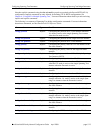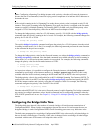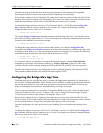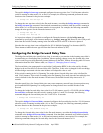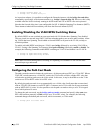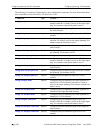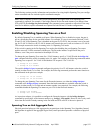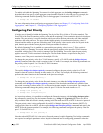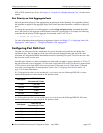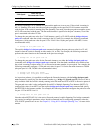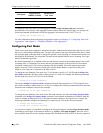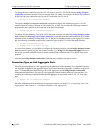
Configuring Spanning Tree Parameters Configuring Spanning Tree Port Parameters
OmniSwitch 6600 Family Network Configuration Guide April 2006 page 5-21
The following sections provide information and procedures for using implicit Spanning Tree port configu-
ration commands and also includes explicit command examples.
Note. When a snapshot is taken of the switch configuration, the explicit form of all Spanning Tree
commands is captured. For example, if the bridge protocol for the flat mode instance was changed from
STP to MSTP, then bridge cist protocol mstp is the command syntax captured to reflect this in the snap-
shot file. In addition, explicit commands are captured for both flat and 1x1 mode configurations.
Enabling/Disabling Spanning Tree on a Port
By default, Spanning Tree is enabled on all ports. When Spanning Tree is disabled on a port, the port is
put in a forwarding state for the specified instance. For example, if a port is associated with both VLAN
10 and VLAN 20 and Spanning Tree is disabled on the port for VLAN 20, the port state is set to forward-
ing for VLAN 20. However, the VLAN 10 instance still controls the port’s state as it relates to VLAN 10.
This example assumes the switch is running in the 1x1 Spanning Tree mode.
If the switch is running in the flat Spanning Tree mode, then disabling the port Spanning Tree status
applies across all VLANs associated with the port. The flat mode instance is specified as the port’s
instance, even if the port is associated with multiple VLANs.
To change the port Spanning Tree status for a VLAN instance, specify a VLAN ID with the bridge slot/
port command when the switch is running in the 1x1 mode. For example, the following commands enable
Spanning Tree on port 8/1 for VLAN 10 and disable STP on port 6/2 for VLAN 20:
-> bridge 10 8/1 enable
-> bridge 20 6/2 disable
The explicit bridge 1x1 port command configures the priority for a VLAN instance when the switch is
running in either mode (1x1 or flat). For example, the following commands perform the same function as
the commands in the previous example:
-> bridge 1x1 10 8/1 enable
-> bridge 1x1 20 6/2 disable
To change the port Spanning Tree status for the flat mode instance, use either the bridge slot/port
command or the bridge cist port command. Note that both commands are available when the switch is
running in either mode (1x1 or flat) and an instance number is not required. For example, the following
commands disable the Spanning Tree status on port 1/24 for the flat mode instance:
-> bridge 1/24 disable
-> bridge cist 1/24 disable
As in previous releases, it is possible to configure the flat mode instance with the bridge slot/port
command by specifying 1 as the instance number (e.g., bridge 1 1/24 enable). However, this is only avail-
able when the switch is already running in the flat mode and STP or RSTP is the active protocol.
Spanning Tree on Link Aggregate Ports
Physical ports that belong to a link aggregate do not participate in the Spanning Tree Algorithm. Instead,
the algorithm is applied to the aggregate logical link (virtual port) that represents a collection of physical
ports.



